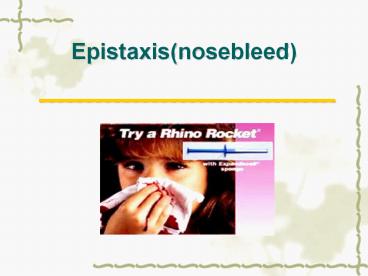Epistaxis(nosebleed) - PowerPoint PPT Presentation
1 / 20
Title:
Epistaxis(nosebleed)
Description:
Epistaxis(nosebleed) Epistaxis Synonyms: nasal hemorrhage, nose bleed, bosebleed, bloody nose. Background: nosebleed is defined as acute hemorrhage from the nostril ... – PowerPoint PPT presentation
Number of Views:1676
Avg rating:3.0/5.0
Title: Epistaxis(nosebleed)
1
Epistaxis(nosebleed)
2
Epistaxis
- Synonyms nasal hemorrhage, nose bleed,
bosebleed, bloody nose. - Background nosebleed is defined as acute
hemorrhage from the nostril, nasal cavity,
nasopharynx. In the majority of the cases,
bleeding is in small quantities and self-limited,
sometimes it can be very intense and
life-threatening. - Incidence with peak in those aged 2-10 years
and 50-80 years. No sex predilection. - Climates factor nose bleed most common occurs
- during colder month and in dry colder climates
3
Epistaxis
- Pathophysiology
- ? Primary bleeding site
- anterior is common. Posterior
- is rare
- ? Littles area is most
- commonly bleeding site (Kieselbach plexus)
- ? Posterior bleeding usually
- originate below the posterior
- half of the inferior turbinate or
- roof of the nasal cavity.
4
Epistaxis
- Cause
- Local causes
- ? Trauma fracture of nasal bone
- ? Infection viral rhinitis, acute rhinitis.
- ? Foreign bodies
- ? Deviation of the nasal septum
- ? Atmospheric change, dry climates
- ? Tumors in nasal cavity and sinuses
5
(No Transcript)
6
Epistaxis
- General Causes
- ? hypertension and heart diseases
- ? pregnancy
- ? Acute general infection
- ? Drugs abuse
- ? Diseases of blood system
7
Epistaxis
- Diagnostic step
- 1.history
- 2.localize bleeding site
- 3.determine causes
- 4.measurement of blood pressure
- 5.analysis of blood coagulation
- 6.radiograph or CT image
8
Epistaxis
- Treatment
- Digital press 10 minutes
- Cautery AgNO3 , laser,
- microwave
- Hardener injection 40 urea
- Nasal packing
- vaseline gauze,
- balloon
- glutin sponge
- compressed sponge
9
Epistaxis
Traditional packing Vaseline gauze ribbon for
2448 hours Prevent infection of sinus with
antibiotic
10
Epistaxis
The step of posterior nasal
packing
11
Epistaxis
- Vascular ligation
- this procedure is used for uncontrolled
life-threatening epistaxis - external carotid artery(ECA) often be
ligated because most nosebleed site is the area
supplied with the branch of ECA . - Calming the patient
- Lowering of blood pressure
- Discontinuation of anticoagulation
- Administration of fluid expanders
12
Epistaxis
- How to prevent rebleeding after initial bleeding
has stopped - Do not pick or blow nose.
- Do not strain or bend down to lift anything
heavy. - Keep head higher than the heart.
- Use a humidifier during dry winter months
- A saline nasal spray will also moisten dry nasal
membranes.
13
Cancer of the nose and sinus
14
Cancer of the nose and sinuses
- General situation
- cancers of nose and sinuses occupy less than
1 of all malignancies and about 3 of all head
and neck cancer. The aetiology is unknown. - Aetiology
- Definite factor dust from hard woods,
nickel - 99 tumor affect the maxillary and ethmoid
sinuses, - only 1 tumor affect the frontal and
sphenoid sinuses
15
Cancer of the nose and sinuses
- Pathology
- 80 of tumor are squmous cell cancer.
- 10 of tumor are adenocarcinoma or adenoid
cystic carcinoma - 1 of nasal tumor are melanomas.
- sarcomas are rare, but in our depatment, we
had once treated some patients with
rhabdomyosarcoma. Most of them are children - recently, the malignant lymphoma in nose and
sinuses often - treated by ENT doctors.
16
Cancer of the nose and sinuses
- Clincal features
- 1.Squmous-cell cancer or basal-cell cancers
usually affect the nasal skin. - 2.Squmous-cell cancer grow faster and may
metastasize to the neck at any stage. basal-cell
cancers grow slowly and and then gradually spread
locally, they do not metastasize. But in advance
stage, they can erode the nose and adiacent cheek
. - 3. It is difficult to distinguish tumor
origination from maxllary sinuses or ethmoid
sinuses.
17
Tumor invading and clinical symptom
? Erode orbital floor diplopia, proptosis
? invade the face cheek bulged, numbness
? enter nasal cavity tears, obstruction
Bloody discharge
? erode tooth and palatine oral cavity
? invade pterygopalatine fossa
trismus
Invasion of nerves will cause headache,
numbness in the face or palate
18
Cancer of nose and sinuses
Tumor of ethmoid sinus
Cancer of maxillary sinus
Nasal cancer
19
Diagnosis
- biopsy and X-ray, CT, MRI confirmation
Malignant teratoma
Ossifying fibroma
Undifferentiated cancer
20
Treatment
- Surgical excision maxillectomy
- Radiotherapy
- Chemotherapy
- Combination therapy
Malignant fibrohistocystosis































